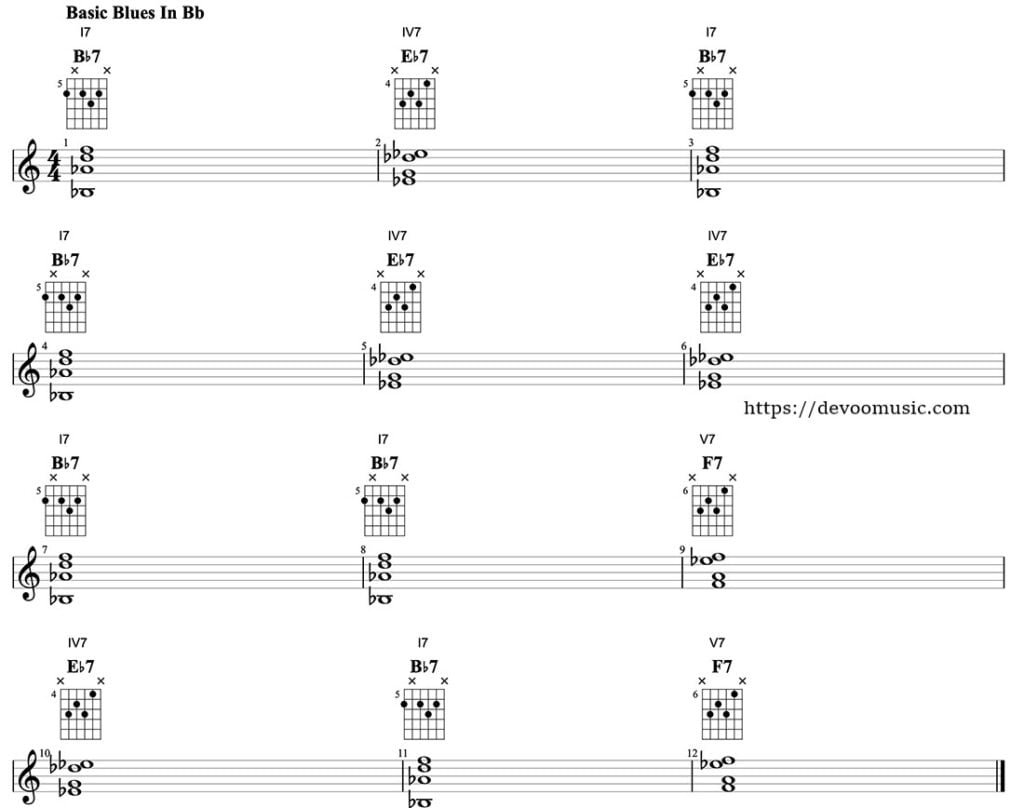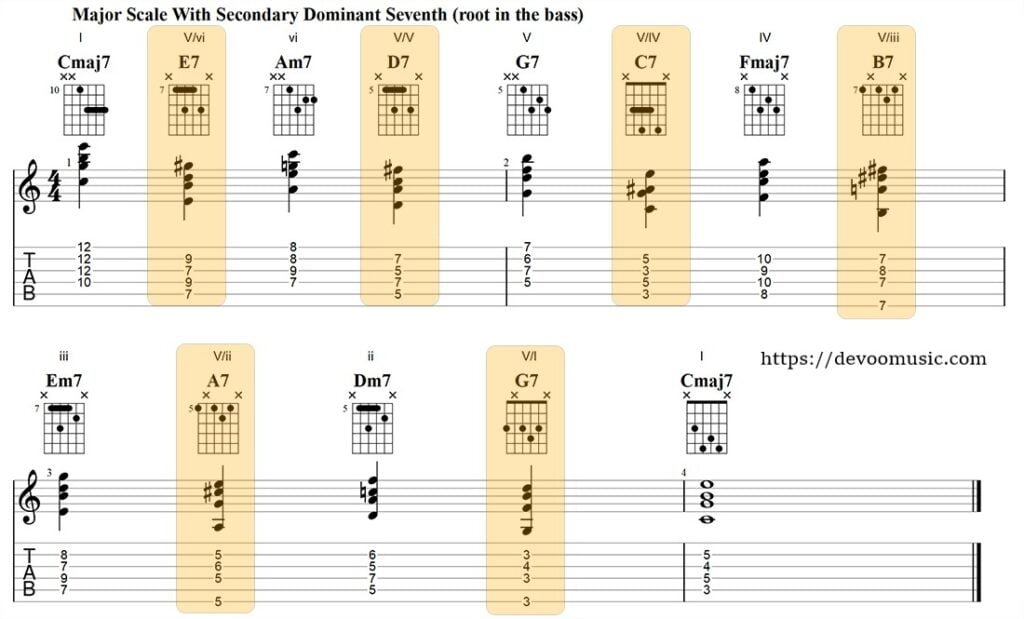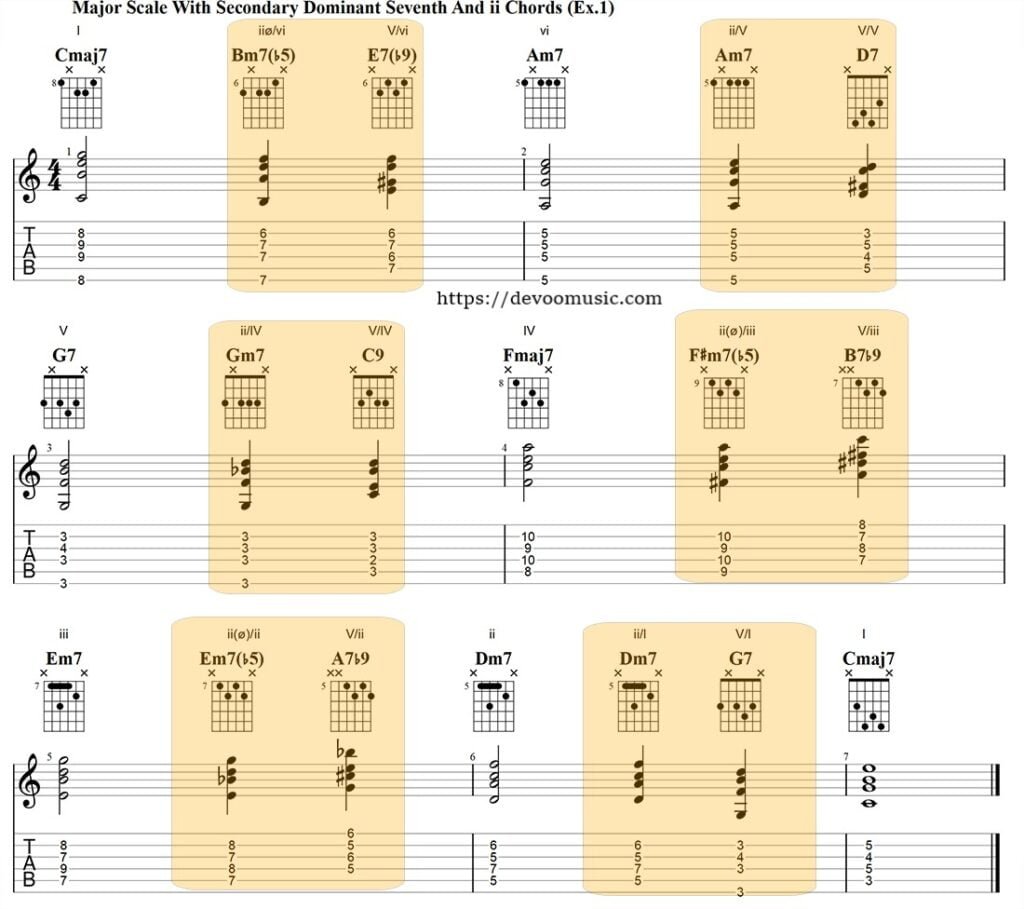Dominant, Subdominant, Secondary Subdominant Chords
In music theory, the terms “dominant,” “subdominant,” and “secondary dominant” are used to describe different types of chords and their functions within a key or harmonic progression. Here’s an explanation of each term with examples for guitar players.
Harmonization Of The Main Types Of Scales
Before learning the difference between “dominant,” “subdominant,” and “secondary dominant” you need to know how to harmonize the main types of scales.
Theses charts represent the harmonization of a specific scale (such as the major scale, natural minor scale, harmonic minor scale, or melodic minor scale) with seventh chords.
Each row in the chart corresponds to a degree of the scale and provides information about the chord built on that degree.
- The “Degree” column indicates the degree of the scale, using Roman numerals (I, II, III, IV, V, VI, VII), in upper case for major and lower case for minor.
- The “Name” column provides the commonly used name for that degree, such as “Tonic,” “Supertonic,” “Mediant,” and so on.
- The “Chord” column specifies the seventh chord built on that degree, indicating the root note and the chord type, such as “A minor 7,” “B diminished 7,” or “C Major 7.”
- The “Seventh Chord Formula” column lists the intervals that make up the chord, relative to the root note. The formula consists of numbers representing the interval steps, such as “1,” “3,” “5,” and “7.”
The lowercase letter “b” signifies a lowered or flattened note, and the “#” or “aug” symbol represents a raised or augmented note. The “bb” symbolizes a double-flattened note. To get the triad formula, just remove the “7”.
By following the chord formulas in the chart, you can harmonize a given scale by building seventh chords on each degree of the scale. This allows you to explore and understand the chord progression and harmonic possibilities within that particular scale.
Chords Of The Major Scale
| Degree | Name | Chord | Seventh Chord Formula |
| 1 | Tonic | C Major 7 | 1 3 5 7 |
| 2 | Supertonic | D minor 7 | 1 b3 5 b7 |
| 3 | Mediant | E minor 7 | 1 b3 5 b7 |
| 4 | Subdominant | F Major 7 | 1 3 5 7 |
| 5 | Dominant | G7 | 1 3 5 b7 |
| 6 | Submediant | A minor 7 | 1 b3 5 b7 |
| 7 | Leading Tone | B half-diminished | 1 b3 b5 b7 |

Chords Of The Natural Minor Scale
| Degree | Name | Chord | Seventh Chord Formula |
|---|---|---|---|
| i | Tonic | A minor 7 | 1 b3 5 b7 |
| ii° | Supertonic | B half-diminished | 1 b3 b5 b7 |
| III | Mediant | C Major 7 | 1 3 5 7 |
| iv | Subdominant | D minor 7 | 1 b3 5 b7 |
| v | Dominant | E minor 7 | 1 b3 5 b7 |
| VI | Submediant | F Major 7 | 1 3 5 7 |
| VII | Subtonic | G7 | 1 3 5 b7 |

Chords Of The Harmonic Minor Scale
| Degree | Name | Chord | Seventh Chord Formula |
|---|---|---|---|
| i | Tonic | A minor(maj7) | 1 b3 5 7 |
| ii° | Supertonic | B half-diminished | 1 b3 b5 b7 |
| III+ | Mediant | Cmaj7#5 | 1 3 #5 7 |
| iv | Subdominant | D minor 7 | 1 b3 5 b7 |
| V | Dominant | E7 | 1 3 5 b7 |
| VI | Submediant | F Major 7 | 1 3 5 7 |
| vii° | Leading Tone | G# diminished 7 | 1 b3 b5 bb7 |

Chords Of The Melodic Minor Scale
| Degree | Name | Chord | Seventh Chord Formula |
|---|---|---|---|
| i | Tonic | A minor(maj7) | 1 b3 5 7 |
| ii | Supertonic | B minor7 | 1 b3 5 b7 |
| III+ | Mediant | C maj7#5 | 1 3 #5 7 |
| IV | Subdominant | D7 | 1 3 5 b7 |
| V | Dominant | E7 | 1 3 5 b7 |
| vi° | Submediant | F# half-diminished | 1 b3 b5 b7 |
| vii° | Leading Tone | G# half-diminished | 1 b3 b5 b7 |

Difference Between Dominant, Subdominant, and Secondary Dominant.
Dominant Chords
In a major or minor key, the dominant chord (or dominant 7 chord) is built on the fifth degree of the scale. It is often represented by the Roman numeral V (Upper case “V” for major, lower case “v” for minor).
In a major key, the dominant chord is usually a major triad (e.g., G major in the key of C major). When adding the 7th to this triad we get a dominant 7 chord (e.g G7 in the key of C).
It is the same for the harmonic minor and melodic minor scales, the dominant chord is a also a major triad (or a dominant seventh chord).
In a minor key (natural), it is typically a minor triad (e.g., E minor in the key of A minor), just add the b7 to get a minor 7 chord.
The dominant chord has a strong tendency to resolve to the tonic chord (the chord built on the first degree of the scale) and is often used to create tension and drive within a musical phrase or progression.
Here are some examples:
Dominant 7 Within Major 2 5 1
One classic example of a jazz chord progression that includes dominant 7th chords is the ii-V-I progression. In the key of C major, the ii-V-I progression would consist of the following chords:
Dm7 (iim7) – G7 (V7) – Cmaj7 (Imaj7)
Here, the G9 chord is the dominant chord. This progression is commonly used in jazz and provides a sense of tension and resolution. The dominant
chord (G7) creates tension that resolves to the tonic chord (Cmaj7).

Dominant 7 Within Minor 2 5 1
Dominant 7th chords can also be used in minor progressions, example with a ii-V-I sequence in the key of A minor:
Bm7b5 (iiø) – E7(b9) (V7) – Am7 (im7)
In this case, the E7(b9) chord is the dominant chord (in harmonic minor and melodic minor scales). The Bm7b5 chord functions as the ii chord in the A minor key, leading to the dominant E7 chord, which then resolves to the tonic Am chord. Notice that the dominant 7th chord is commonly altered with the b9, b13.

Dominant 7 In Basic Blues
Basic blues progressions exclusively features dominant-type chords. It means that when constructing basic blues chord progressions, the tonic (I7), subdominant (IV7), and naturally, the dominant (V7) chords are all of the dominant type, characterized by the notes 1, 3, 5, and b7. Here is an example in Bb :

Dominant Chord In Minor (Natural) Keys
In natural minor scales, the fifth scale degree is a minor chord. Therefore, the term “minor dominant chord” can be a bit misleading.
When transitioning from a minor v chord to a minor i chord, it doesn’t create the same level of tension as the transition from a major triad or dominant V chord would produce. That’s why it is common to replace the v chord by a major triad or dominant 7th chord as it is the case in melodic and harmonic minor scales.
Here are some examples of minor progressions including dominant chords.
Example 1 : im7 v7 im7 (Am7 Em7 Am7)
In this first example the dominant chord is minor (Em7) .

Example 2 : im7 V7 im7 (Am7 E7 Am7)
This one is the same as the previous but with a dominant 7 chord (E7) instead of the minor dominant.

Example 3 : im7 V7 ivm7 VII7 IIImaj7 V7 im7 (Amin7 – E7 – Dmin7 – G7 – Cmaj7 – E7 – Amin7)
Here is a longer progression in Am including a dominant 7 chord as the V instead of a minor 7.

Example 4 : i – #idim7 – iiø – V7 (Am – A#dim7 – Bø – E7)
This contains one passing chord (A#dim7) to create a smooth transition (voice leading) between the im7 and iim7b5.

Subdominant Chords
In basic theory, the subdominant chord is built on the fourth degree of the scale and is commonly represented by the Roman numeral IV. (Upper case “IV” for major, lower case “iv” for minor).
In major keys, the subdominant chord is typically a major triad (e.g., F major in the key of C major), while in minor keys, it is usually a minor triad (e.g., D minor in the key of A minor), except for the melodic minor scale where it is a major triad.
The subdominant chord provides a sense of stability and is often used as a contrast to the dominant chord. It frequently precedes the dominant chord in progressions and can create a feeling of anticipation or preparation for the resolution to the tonic.
The chart below show the subdominant seventh chords for each major scale.
| Major Scale | Subdominant Seventh (IV7) Chord | Chord Symbol | Notes in the Chord |
|---|---|---|---|
| C major | F7 | F7 | F – A – C – Eb |
| C# major | F#7 | F#7 | F# – A# – C# – E |
| D major | G7 | G7 | G – B – D – F |
| Eb major | Ab7 | Ab7 | Ab – C – Eb – G |
| E major | A7 | A7 | A – C# – E – G |
| F major | Bb7 | Bb7 | Bb – D – F – Ab |
| F# major | B7 | B7 | B – D# – F# – A# |
| G major | C7 | C7 | C – E – G – Bb |
| Ab major | Db7 | Db7 | Db – F – Ab – C |
| A major | D7 | D7 | D – F# – A – C |
| Bb major | Eb7 | Eb7 | Eb – G – Bb – D |
| B major | E7 | E7 | E – G# – B – D# |
Subdominant Chords In Jazz
In jazz, the subdominant chord is more commonly the ii chord (built on the second degree of a major scale) and less commonly the vi chord. Jazz musicians refer to this as the “subdominant” since it combines the subdominant and supertonic elements.
By using the ii7 chord, which is derived from the supertonic degree of the major scale, jazz musicians introduce more chromatic movement and a stronger pull towards the dominant chord. This progression, such as ii7 – V7 – I, is a common jazz cadence.
The following chart show the iim7 and V7 chords in all twelve keys.
| Major Key | ii minor seventh (iim7) Chord | Dominant seventh (V7) Chord |
|---|---|---|
| C major | Dm7 | G7 |
| C# major | D#m7 | G#7 |
| D major | Em7 | A7 |
| Eb major | Fm7 | Ab7 |
| E major | F#m7 | B7 |
| F major | Gm7 | C7 |
| F# major | G#m7 | C#7 |
| G major | Am7 | D7 |
| Ab major | Bbm7 | Eb7 |
| A major | Bm7 | E7 |
| Bb major | Cm7 | F7 |
| B major | C#m7 | F#7 |
Secondary Dominant Chords
A secondary dominant chord (or a dominant approach chord) is a chord that temporarily functions as the dominant of a chord other than the tonic. It is is used to tonicize the chord you are moving to, create additional tension and harmonic interest.
A secondary dominant is built on a scale degree other than the fifth and is represented by the Roman numerals V/V, V/ii, V/iii, etc., where the number after the slash indicates the degree of the temporary tonic.
For example, in the key of C major, the dominant chord of the dominant (V/V) is D major (D, F#, A), and the dominant chord of the relative minor (V/vi) is E major (E, G#, B).
Secondary dominants are commonly used in progressions to modulate to different keys or to create chromatic harmonies. Remember that any chord can be preceded by its secondary dominant.
Here is a recapitulative chart showing the secondary dominant of each chord of the diatonic major scale.
| Chord | Roman Numeral | Secondary Dominant | Roman Numeral of Secondary Dominant |
|---|---|---|---|
| Cmaj7 | I | – | |
| Dm7 | ii | A7 | V7/ii |
| Em7 | iii | B7 | V7/iii |
| Fmaj7 | IV | C7 | V7/IV |
| G7 | V | D7 | V7/V |
| Am7 | vi | E7 | V7/vi |
| Bm7b5 | vii° | F7 | V7/vii° |
Secondary Dominant In Major 1 6 2 5
Here you can hear A7 the secondary dominant (V/ii) of the iim chord (Dm9).

Secondary Dominant Chord Substitution
Here is another possibility of secondary dominant chord borrowed from the harmonic minor scale (degree VII). In the example, C#dim7 is a substitute for the A7(b9) the secondary dominant chord of Dm7.

Major Scale Chords And Secondary Dominants
In the following exercise, you can hear the chords of the C major scale (descending) and their secondary dominant chords. Notice the viiø chord (Bm7b5) has been voluntarily omitted.

Major Scale, Secondary dominants And Secondary Subdominants
Here is the same progression with secondary subdominant chords added. Even if the therm of secondary subdominant is debatable (some theorist just call them “short modulation), the result is the same, they have the function of II of…. as shown in the example below.

To summarize, the dominant chord is built on the fifth degree of the scale and has a strong tendency to resolve to the tonic. The subdominant chord is built on the fourth degree (or second in jazz theory) and provides stability and contrast. Secondary dominant chords temporarily act as dominants for chords other than the tonic, adding tension and harmonic complexity to a progression.



